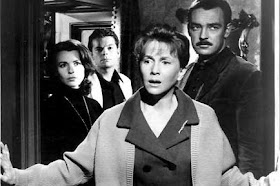Most
people who write a best movies list that includes a movie with
Katherine Hepburn choose something other than Desk Set. They
may prefer Pat & Mike or
Adam's Rib, titles
that are much better known. Almost certainly, they would name The
African Queen, which deserves to
be honored.
In
fact, The African Queen
will be the subject of my next blog entry. And of all the romantic
comedies that Katherine Hepburn and Spencer Tracy made together, Desk Set is my favorite – for one
simple reason. It's a science fiction movie.
No,
it doesn't have ray guns, space ships, or aliens. But it satisfies
one of the most basic criterions of a science fiction plot: it's
about how technology changes the lives of people who use it. In this
case, it's about a civilian application for an early computer, the
EMERAC (probably based on the UNIVAC and the ENIAC). Spencer Tracy
plays the efficiency expert who is adapting the computer for a
business interface, and Katherine Hepburn is the head of the
reference department at a New York Magazine that will try to
integrate the big computer into their operations. Since the computer
processes questions and is supposed to come up with instant answers,
the reference staff is understandably nervous about their jobs.
This
is one of the main conflicts in the story. The employees in the
reference department are all female, and you get a glimpse into the
lives of an earlier generation of working women. The wonderful Joan Blondell is Peg Costello – who, like the other gals in her
department, is single, independent, and older than people probably
expected a working woman to be in those days – old enough to be
married, in other words. They have to be ingenious to make ends
meet, but you get the feeling that none of them have met a man for
whom they would be able or willing to give up their independence –
except, possibly for Hepburn's character, Bunny Watson. She does
have a fella she's serious about: Mike Cutler, played by Gig
Young. But he keeps putting her off until his career takes off,
something it always seems to be on the verge of doing. By the time
the computer shows up, he's starting to take her for granted.
That's
the other conflict in the story. Because Tracy's character, Richard
Sumner, is quite charmed by her. He's fascinated by the way the
women perform their jobs, especially by the way their memories work.
He notices that Bunny uses association as a memory tool. And he
enjoys the quick, witty responses she comes up with when they talk.
I suspect he also notices her trim figure and dazzling smile, but he
is so unassuming and courteous, this is more of a conclusion than an
observation.
Bunny
tries very hard not to like Richard – after all, he's programming
the electronic monster that will make her obsolete. But something
between them just seems to click, and pretty soon the luke-warm
boyfriend begins to notice that he's got competition. Suddenly he's
not so inclined to take her for granted. But will he rally in time?
If
you're familiar with the pattern in Hepburn-Tracy movies, you already
know the answer to that question. But the characters are so likable,
you just can't help getting caught up in their lives. And in the
meantime, the big computer is looming over everybody's job, until the
day when it generates a bunch of pink slips for the reference
department. Neither love nor computerization goes smoothly for
anyone in this film.
But in the end, you cheer for both. Desk Set is not a grand film that forever changed the art form. But it is an irresistible snapshot of a particular time and place, a moment of change in American business and American romance. I watch it at least once every year, so I can take a brief vacation to that time and place. That's why it goes on my list of the best.













